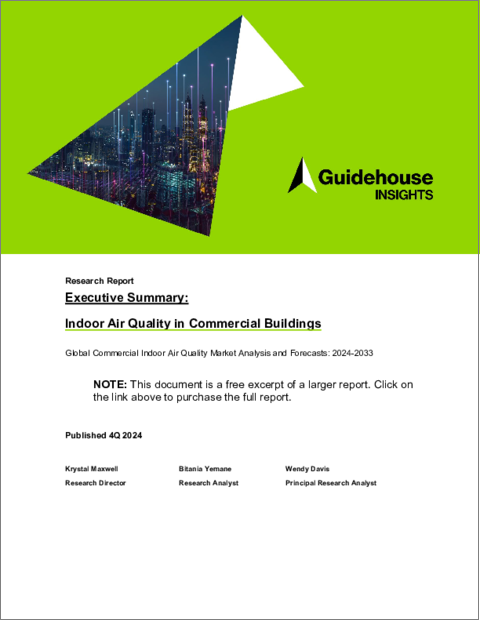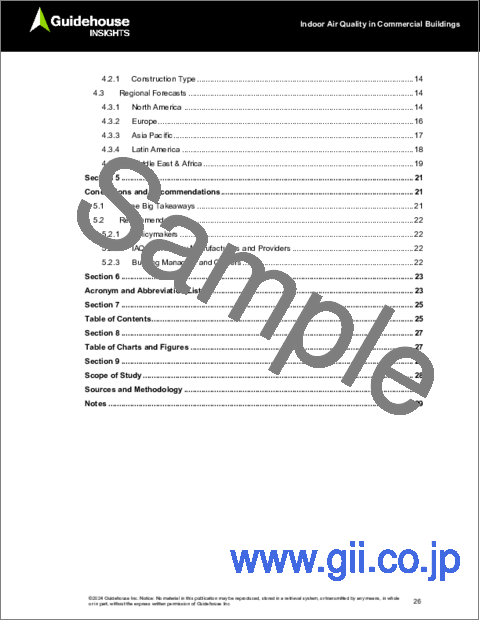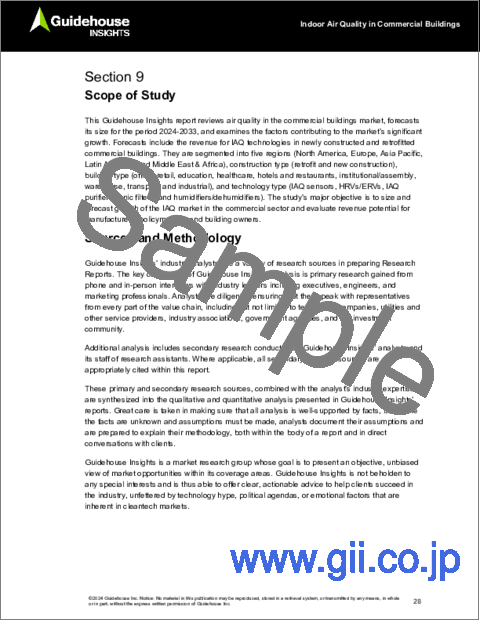|
|
市場調査レポート
商品コード
1642862
商業ビルの室内空気品質 (IAQ):世界市場の分析・予測 (2024-2033年)Indoor Air Quality in Commercial Buildings: Global Commercial Indoor Air Quality Market Analysis and Forecasts, 2024-2033 |
||||||
|
|||||||
| 商業ビルの室内空気品質 (IAQ):世界市場の分析・予測 (2024-2033年) |
|
出版日: 2024年12月30日
発行: Guidehouse Research
ページ情報: 英文 30 Pages
納期: 即納可能
|
全表示
- 概要
- 目次
世界の商業ビルの室内空気品質 (IAQ) の市場は、規制基準の強化や技術の進歩に後押しされ、今後10年間は安定した成長が見込まれています。劣悪なIAQと呼吸器系の健康問題との関連性に対する懸念が高まるに中で、加湿器/除湿器、熱回収換気装置 (HRV) およびエネルギー回収換気装置 (ERV)、空気清浄機、センサーなどのIAQ技術は、病院、教育機関、オフィス、倉庫、小売スペースなど、あらゆる種類の商業ビルにおけるビル所有者および居住者にとっての優先事項となっています。
商業ビル向けIAQ技術市場の最大の促進要因は健康への意識であり、COVID-19の流行後、IAQが健康に与える影響に対する一般市民の理解が深まり、商業ビルにおけるIAQ技術の改善に対する需要が牽引されています。WELLや欧州のEPBD (Energy Performance of Buildings Directive) 指令などの建築基準は、顧客満足度を向上させ、居住者の安全と健康を確保し、企業の持続可能性目標を達成するために、建築物の認証を求めるよう企業に圧力をかけています。EPBDは、IAQ基準を満たすための改修の必要性が大きい既存のインフラに適用されます。IAQモニタリング、センシング、高度換気システムの技術革新などの技術進歩は、よりエネルギー効率の高いソリューションを生み出し、特に北米、欧州、アジア太平洋での導入拡大に貢献しています。成長に対する課題としては、高い初期費用と地域間の規制の欠如が挙げられ、特に多国籍製造業者やプロバイダーにとっては、世界の規制の不整合が大きな課題となっています。
当レポートは、世界の商業ビルの室内空気品質 (IAQ) の市場を調査し、市場概要、市場促進要因と課題、競合情勢、市場規模の推移・予測、新築/改修建物・技術タイプ・地域別の内訳、参入事業者への提言などをまとめています。
目次
第1章 エグゼクティブサマリー
- 市場概要
- 市場促進要因と障壁
- 世界市場のハイライト
第2章 市場の問題
- 市場促進要因
- 技術の進歩
- 建築基準と認証
- 企業の持続可能性への取り組みと目標
- 健康とウェルネスの意識
- 従業員エクスペリエンスとテナント維持
- 市場の障壁
- 初期費用の高さ
- 規制と標準化の問題
- メンテナンスと運用上の課題
- 教育と意識の欠如
- 改修と統合の複雑さ
- 価格
第3章 産業バリューチェーン
- 市場ステークホルダー
- 競合情勢
- M&A
第4章 市場予測
- 調査手法
- 世界市場の予測
- 建設タイプ
- 地域予測
- 北米
- 欧州
- アジア太平洋
- ラテンアメリカ
- 中東・アフリカ
第5章 総論・提言
- 3項目の主な要点
- 推奨事項
- 政策立案者
- IAQ技術製造業者およびプロバイダー
- ビル管理者および所有者
第6章 頭字語・略語一覧
第7章 目次
第8章 図表
第9章 調査範囲・情報源と調査手法・注記
The global market for air quality technologies in commercial buildings is expected to experience steady growth in the next 10 years, fueled by tightening regulatory standards and technological advances. As concerns about the connection between poor indoor air quality (IAQ) and respiratory health issues have risen, IAQ technologies-such as humidifiers/dehumidifiers, heat recovery ventilators (HRV) and energy recovery ventilators (ERV), air purifiers, and sensors-have become a priority for building owners and occupants in all commercial building types, including hospitals, educational institutions, offices, warehouses, and retail spaces.
The largest driver of the commercial IAQ technologies market is health awareness, prompted by the public's understanding of IAQ's impact on health, which surged after the COVID-19 pandemic, driving the demand for improved IAQ technologies in commercial buildings. Building standards, such as WELL and Europe's Energy Performance of Buildings Directive (EPBD) have pressured businesses to seek building certifications so that they can improve customer satisfaction, help ensure occupant safety and health, and meet corporate sustainability targets. The EPBD applies to existing infrastructure where the need for retrofitting to meet IAQ standards is significant. Technological advances, such as innovations in IAQ monitoring, sensing, and advanced ventilation systems, are creating more energy efficient solutions, helping to increase adoption especially in North America, Europe, and Asia Pacific. Barriers to growth include high upfront costs and the lack of regulatory mandates across regions; global inconsistencies in regulations, especially for multinational manufacturers and providers, pose significant challenges.
This Guidehouse Insights research report examines the global market for air quality technologies and devices in commercial buildings. Forecasts for commercial IAQ equipment, segmented by newly constructed and retrofitted buildings and technology type, cover the 10-year forecast period of 2024-2033.
Table of Contents
1. Executive Summary
- 1.1 Market Overview
- 1.2 Market Drivers and Barriers
- 1.3 Global Market Highlights
2. Market Issues
- 2.1 Introduction
- 2.2 Market Drivers
- 2.2.1 Technological Advances
- 2.2.2 Building Standards and Certifications
- 2.2.3 Corporate Sustainability Initiatives and Goals
- 2.2.4 Health and Wellness Awareness
- 2.2.5 Employee Experience and Tenant Retention
- 2.3 Market Barriers
- 2.3.1 High Initial Costs
- 2.3.2 Regulatory and Standardization Issues
- 2.3.3 Maintenance and Operational Challenges
- 2.3.4 Lack of Education and Awareness
- 2.3.5 Complexities in Retrofits and Integration
- 2.4 Pricing
3. Industry Value Chain
- 3.1 Market Stakeholders
- 3.2 Competitive Landscape
- 3.2.1 Merger & Acquisition Activities
4. Market Forecasts
- 4.1 Methodology
- 4.2 Global Market Forecast
- 4.2.1 Construction Type
- 4.3 Regional Forecasts
- 4.3.1 North America
- 4.3.2 Europe
- 4.3.3 Asia Pacific
- 4.3.4 Latin America
- 4.3.5 Middle East & Africa
5. Conclusions and Recommendations
- 5.1 Three Big Takeaways
- 5.2 Recommendations
- 5.2.1 Policymakers
- 5.2.2 IAQ Technology Manufacturers and Providers
- 5.2.3 Building Managers and Owners





